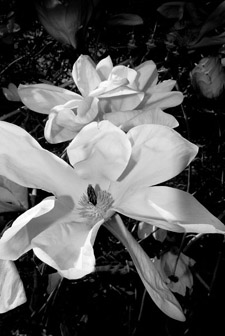Digital Black and White
![]()
Digital Black and White
By George Schaub
When digital arrived it hardly seemed a scheme that would be any good for my
black and white photography. I now see it as an essential part of the way I
work. This required some translation and transition from film and chemical photography,
but it also required a redefinition of how things work.
There are a number of matters at the heart of black and white photography that have changed, or at least should be looked at in a new light. For example, I always considered density (exposure plus development) as the arbiter of contrast and tonality; now I appreciate the incredible malleability of the information in the codes that make up a digital image. I had always thought that using larger format film equaled better quality prints, with more detail and greater magnification potential; now I consider pixel resolution, resampling and perhaps most importantly, bit depth as my criteria for enlargeability. My processing and printing regimen always included so-called archival processes; now I have found printing systems and ink/paper combinations that rival and sometimes surpass even the most archivally processed silver print materials in terms of longevity and fade-resistance. I would often struggle making decent prints from color images. Software programs now have numerous controls for converting color to monochrome with user-controlled input or various presets for any "look" I desire. Indeed, the very nature of the digital camera image--RGB--lends itself to custom "conversions", which can emulate the effect of placing color filters over the lens as you work.

There is of course an ongoing debate about the superiority of film over digital black and white techniques. I will not attempt to settle that argument for anyone whose flag is firmly planted in one camp or another. Personally I have many, many film images that I work with in the digital realm, which I accomplish through scanning. My experience is that the larger the format, and the more care taken when the film image was made in terms of focus and exposure, the better the results. This goes without saying, and actually remains true when doing digital capture. It's just that some of the rules of the road have changed in terms of exposure and how we relate to what format means.
I will not work in the chemical darkroom again, mainly for health reasons, but yes, for control and quality reasons as well. All this is not to say that digital black and white is superior to film black and white photography. It's a choice you make in terms of your medium; that choice, however, should be an informed one, and can rely solely on a fully digital environment or incorporate the best of both worlds.

There's no denying that digital has changed the way in which most photographers make pictures and share them; in some ways it has had an even more profound effect on black and white photographers and printers. Why more profound? In many ways black and white photographers were the last bastions of "traditional" photography. Rare was the color photographer who processed his or her own film, and even rarer was it to make prints, especially from color slides. Black and white photographers always had more control over tonality and contrast, and could make nature and landscape images when color slide photographers could only rest in the shade on a bright, sunny day. They studied formularies and agitation schedules for developing film, and made careful spot readings and exposure compensation followed by custom development to wring the most tonal value from each scene. At least quite a few did, and many more knew the curriculum was there for the studying.
But there's something about black and white that remains the same, be it digital or film. What has not changed is the magical quality of the black and white image. In terms of pure visual enjoyment, there is the beauty of the tonal values--the shades of gray, deep blacks and bright whites--that express the play of light and shadow unlike any other medium. The tones are versatile, and can be made to represent with equal power both the hard glint of light off freshly-fallen snow and the soft, diffuse light of fog rising from a river valley on an autumn morning.

Black and white reveals a world that allows us to visualize without the distraction of color. This permits us to approach the heart of a subject, or natural design in its purest form. It also gives creative freedom, as the artistic intent of the photographer can be applied in every step of the final creation of the image, from the way in which we "see" and interpret the subject to the incredible variety of choices in image processing and printing.












































